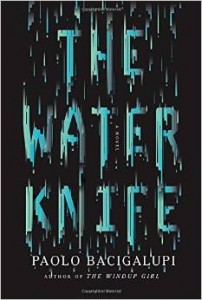Fiction can provide a useful framework for thinking through alternative approaches to real problems. In that regard, I’m enjoying Paolo Bacigalupi’s new novel The Water Knife.
Set in the near future Colorado River Basin, the book makes water management seem genuinely exciting. I’ll avoid spoilers, but try to give some flavor.
The opening scene involves the general counsel for the Southern Nevada Water Authority winning a court curtailment order against an Arizona community whose junior water right use is apparently interfering with Las Vegas’s senior supply. The lawyer hands off the paperwork to the SNWA water rights enforcement team, which takes to the sky in a squadron of armed helicopters and blows up the junior users’ water treatment plant. This assures that water is not taken out of priority.
Bacigalupi here calls on a couple of important water policy tools that advocates frequently point to in discussing possible solutions to our water problems. The first is clear adjudication of water rights priorities, determining who stands where in line with respect to their neighbors when water runs short. This is currently unevenly applied in the western United States. The second is the idea of interstate movement of water – in this case Nevada claiming priority over an Arizona user. This is sometimes advocated, though not currently allowed under the law.
These tools, while beyond the way we currently do things, are not conceptually new. People have talked about them for years. The real policy innovation is the part where water agencies employ armed militias to blow stuff up. This is not currently permitted under the “Law of the River”.
Water nerds are gonna love this book.


Hey John, next time you’re around go check out Besh ba Gowah archaeological park in Globe, AZ. You’ll find an ancient Water Knife story there. Very interesting.
ach! just started reading this because i ran out of other books to read and found a bug.
(SPOILER, don’t read past this if you are going to read the book)…
the author writes about intake #3 and what happens if the water goes below that level, but isn’t intake #3 a dead pool intake that will get water no matter what? it’s not like the Colorado River is going to go dry above Lake Mead… at least, not any time soon…